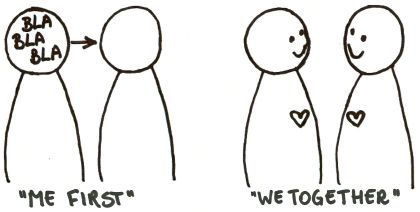The Art of a Good Conversation with Greenzone Communication
Workshops in English, onsite in Europe.
Greenzone communication offers us a save haven, where we can be open and connected – to ourselves and others. When we are supported by our greenzone friends, we can be genuine and vulnerable, and we can be honest about the messiness of our daily conversations.
In a greenzone, we can become aware of our common humanity, be mild to ourselves and to others, and be honest about the misunderstandings in our relationships and the consequences of this. Then, we can start to have healing dialogues. We learn about ourselves, grow our awareness in the moment, and repair our relationships.

Esther Hasselman is co-author of the Greenzone chapter in The Art of Mindful Communication,
Trained in Greenzone Communication by Susan Gillis Chapman and Gregory Heffron,
Certified mindfulness and mindful communication teacher, based in The Netherlands.
EAMBA webinar about Greenzone Communication
We have been invited by EAMBA (European Association for Mindfulness) to host a webinar on Greenzone Communication on December 29, 2023. This one will be donation-based. Please join in, welcome! Check out the EAMBA events calendar for more information.
The English book: Mindful Communication
The translated and adjusted version of our book has been released in the UK in 2023. The title: ‘Mindful Communication – Speaking and Listening with Wisdom and Compassion’. The book describes six methods for mindful communication, one of which is Greenzone Communication.
I have been co-working with my dear colleagues and friends Chris Trani and Greg Heffron, and I am very happy with the result. We took the original chapter that I had written for the Dutch release in 2020, translated it and – as we got a few hundred extra words – we added some cool extra stuff!
Are you always fully invested in your conversations?
… or do you recognize one (or all!) of these examples?
Sometimes I am ‘enchanted’ by my own story, and so eager to tell people what I think, believe or have dug up from deep within myself, that I have totally lost all sense of whether the other person is still listening.
Another thing that happens regularly is somebody telling me something when he or she mentions a specific word, e.g. ‘car.’And all the sudden, my attention is outside, where I had been parking my car. “Did I forget to activate the parking app?” Meanwhile, I have no idea what the person in front of me is talking about.
Or I am walking in town and I meet somebody who I haven’t seen for a long time. While the other person is chatting about … I don’t know what about … Oh, yes! I wasn’t there for him, because I was completely involved in an inner dialogue. I just couldn’t remember his name and I was digging in my memory.
Or—and this will be the last example for now, but I could easily add another 20—somebody is in the middle of telling me a story and I think I already know the outcome. My thoughts are running ahead, and as soon as the mouth of the teller stops moving, I jump in and say something that is supposed to sound really understanding. The teller shuts down; I am totally missing the point. The connection between us is lost.
Are you sometimes distracted, mindless, unattentive – just like me?
You are not alone! We all suffer from distractedness, from closing off of our conversations.
And more good news: we can learn and develop our communication skills with Greenzone communications. This method takes our daily mindfulness practice and applies it to our daily conversations and relations.
When we become mindfully aware of what is happening in the moment, we can navigate ourselves back into contact with the other person, repairing the ‘We together’ mode (as opposed to a ‘Me first’ mode).
Sometimes this happens quickly and smoothly, but it may also take some time. Sometimes we can go our own, cut-off way for an hour, sometimes we fall asleep in that mode and find ourselves waking up in more than one sense the next morning.
This is what daily life looks like. Usually, we all have good intentions. We got up, we did a short morning meditation, and we have set our intention for the day (“May I be patient today, with myself and with every person that I meet,”) … We are ‘all Zen’.
And then our day begins …
Just like in traffic, our communication goes, and than it stops again. We use a traffic light to symbolize this. Do you recognize this alteration of ‘red light’ and ‘green light’ in your daily conversations?
Coming off of your cushion – mindfulness in relationship
As soon as we step into the world again, we encounter situations and people. Good practicing material. Often, this material is more challenging to practice with than the stuff we had come in terms with while sitting on our meditation cushion.
People we meet all have their own moods, thoughts, agendas and rhythm. Just like us. And they don’t always seem to line up.
A few years ago, during the introduction of a silent retreat, they talked about why we were not at home, practicing silence by ourselves, but instead we were going to practice together, in a group:
“It is like washing potatoes. You don’t hold them under water one by one; you put them together in a pan and move them around in the water, so that they rub each other clean.”
The rubbing in our day-to-day situations – opening and closing, engagements and distractions – becomes the practicing material in Mindful Communication. During training and practice groups we don’t concentrate on the content of our communication, but on the communication itself. Mindful Communication is the practice.
‘The Five Keys to Mindful Communication,‘ published in 2012 by Susan Gillis Chapman is a good introduction to this kind of approach. She is a genius in the field of Mindful Communication, and is a walking encyclopedia filled with theory, anecdotes and examples.
Gillis Chapman had developed an equally easy and workable model: a traffic light system. Her business partner Greg Heffron explains the traffic light model in the video beneath. (There are also exercises in the book that you can do yourself.)
Note that Susan Gillis Chapman is in the process of retiring, and that her team (including Greg Heffron and Esther Hasselman) are continuing her work.
Is the traffic light green?
The basic model that Susan Gillis Chapman introduces and elaborates on in her boek is the traffic light metaphore:
- Green: We Together; we are both mindful, present, and connected in the moment. GO!
- Red: Me First; we (both) are mindless, distracted, and disconnected from the moment. STOP!
- Yellow: a wobbly stage in between red and green, in which we are insecure. There are questions, doubts and uncertainties. BE CAREFUL!
This may seem quite simple, and in fact it is. But as with mindfulness in general:
It is simple, but far from easy!
Our gatherings
In our workshops and retreats, we dive into this model, where we explore the three colours, and variations of all three. We find that the red light has several flavours, and that the yellow light includes different kinds of fear that need careful attention. We translate the model into our own lifes; it really is a practicle, hands-on method!
EAMBA webinar about Greenzone Communication
We have been invited by EAMBA (European Association for Mindfulness) to host a webinar on Greenzone Communication on December 29, 2023. This one will be donation-based. Please join in, welcome! Check out the EAMBA events calendar for more information.
Greg Heffron is the co-founder and director of te Greenzone Institute in the US (California). Of course, he too is available for workshops, and he usually visits Europe every year.
Esther Hasselman can make herself available throughout the year.
In case of larger groups, we can co-teach.
A ‘Green Zone’ is a safe place
A “Green Zone” is a safe area (the term comes from specific safe areas that are created in war zones). In this Green Zone we create a field of green light – a green zone. We can create an individual green zone, or we may create one with another person, or even with a group.
Can you think of some conditions for good communication?
A rule of thumb for Mindful Communication: “We-first”
This does not mean that you only talk about “nice” things with each other. But before you talk about any matter, you first take care of the relationship in the moment: is the listener willing and able to hear what you want to say?
You check this over and over, moment to moment, during the communication session. You keep checking if the light is green (both for yourself and your communication partner).
Mindful Communication Courses and Retreats
I would be happy to come over to the UK or any other countries where participants speak and understand English at an intermediate level (tailor-made, let’s talk!)
Besides the possibility to do workshops or retreats onsite in Europe, there are online courses on different levels:
- Introduction course (pre-recorded)
- Community with bi-weekly gatherings
- Advanced training
- Teacher training
Please refer to the US website to find out more about these online options
EAMBA webinar about Greenzone Communication
We have been invited by EAMBA (European Association for Mindfulness) to host a webinar on Greenzone Communication on December 29, 2023. This one will be donation-based. Please join in, welcome! Check out the EAMBA events calendar for more information.




